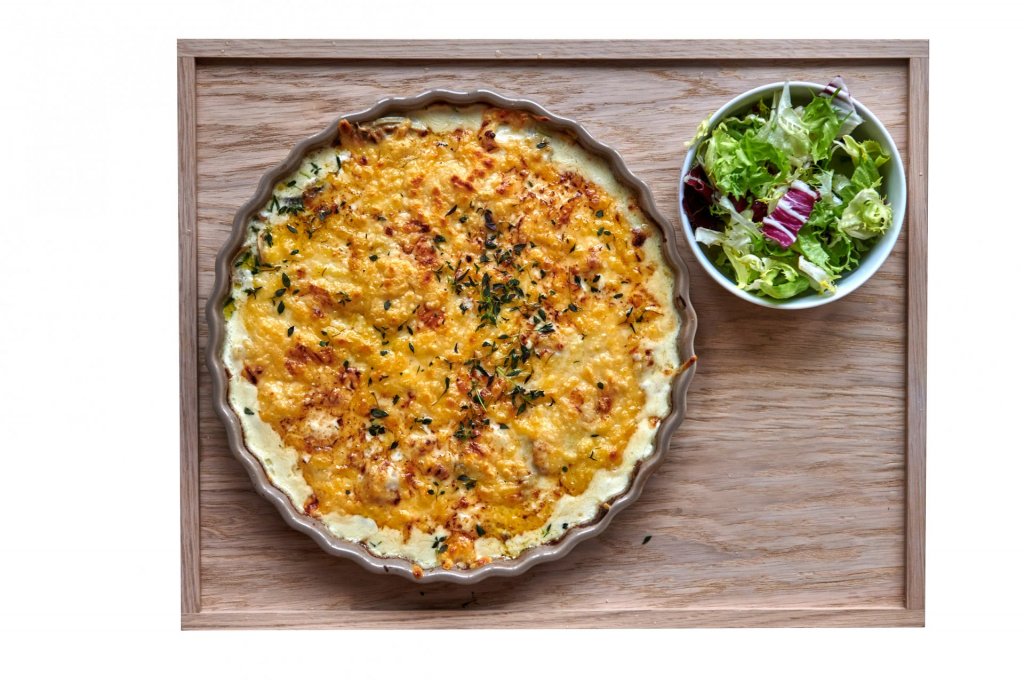6. 6. 2022
Fire is the heart of the kitchen
Simon Johnson, CEO of CRESTYL Czech Republic, was born in the UK but has been at
home in the Czech Republic for 26 years. Professionally, he excels in managing
the development of large neighborhoods, but his other expertise and great
passion flourishes in one very specific space – the kitchen. It was there
that an informal and very pleasant interview took place for you, dear readers of
DOCK magazine.
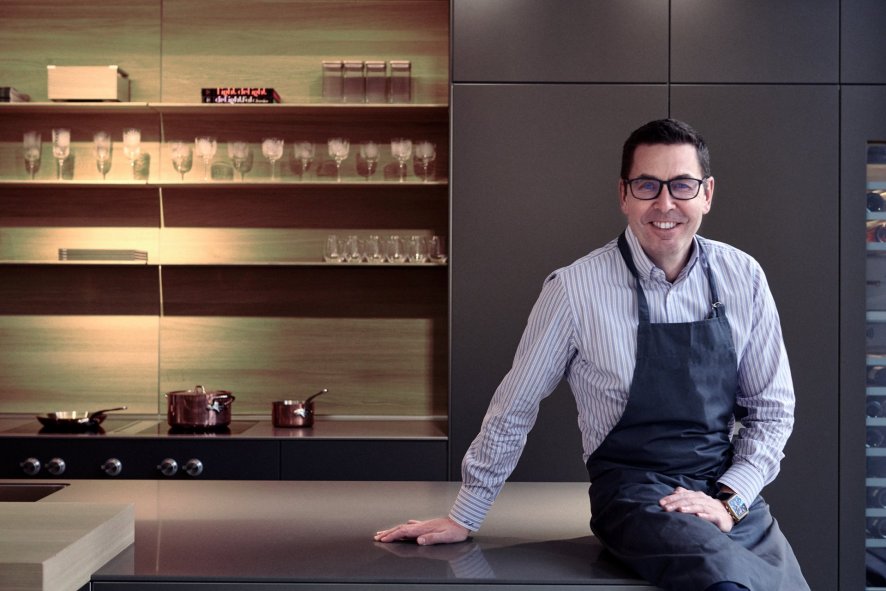
We know that you are a gastronomic connoisseur and an excellent chef. Of all things, why did cooking win you over?
For me, food is a bit of a ceremony. It's a natural joy, whether you indulge in it in a restaurant or make a meal at home. It is a combination of tastes, aromas and the ritual itself. I consider it one of the most beautiful parts of everyday life. We should celebrate food, not just feed ourselves.
How often do you manage to set aside well-deserved time and space for a food celebration in your busy schedule?
Unfortunately, not enough on weekdays, but at the weekend I like to cook and devote the necessary time to it. During the work week, I often have business dinners. It's part of my life, so I like to perform that ceremony as part of business events. And in doing so, I can please both the client and myself.
Unfortunately, our readers can't experience it, but your menu today looks and smells wonderful. Why did you choose French onion soup and mussels mariniere according to the recipes of world-famous chef Julia Child?
Good question. Those are the meals that I always manage to make just right (laughs). When I cook them for someone, I succeed every time. Everybody knows and loves French onion soup. And her mussels mariniere are amazing, though admittedly, seafood is generally not so common here in the Czech Republic.
And why Julia Child? Do you see her as an icon? Is French cuisine your favorite?
As for the inspiration from Julia Child – when I lived in Slovakia, my wife and I watched the movie Julie & Julia. In it, we meet chef Julia Child at the onset of her career and at the same time, the story of Julie Powell plays out, a lady who wants to cook all 524 recipes from Child's cookbook in the span of just one year. I chose the same path. I didn't manage to "cook up" everything from both of her cookbooks, but when we lived in Slovakia, I tried making one of her recipes every day, day after day, for a year and a half... So Julia Child influenced me greatly. Her recipes are quite different from those you commonly find in magazines. Through them, one really learns to cook, learns the preparation of sauces, and various ways of preparing meat and vegetables. There's a slightly different mentality, a different logic. This captivated me and moved me to this very art of French cuisine.
What is most important for you in the kitchen?
Fire, wine and music. By fire I mean a gas stove. Although I’ve tried cooking on super-quality induction stoves, for me fire is simply the heart of the kitchen. In addition, cooking with gas give me more flexibility, the ability to respond better to what is happening in the pot. Wine must never be missing in my kitchen. For me, the cooking process is connected with wine tasting and, of course, good company. And I certainly can't imagine cooking without music.
What music do you listen to while cooking? What kind inspires you the most?
I like to listen to beautiful classical or jazz music. I outfitted my kitchen with a spectacular sound system. But my wife despises it because it has extraordinarily large speakers (laughs).
What ingredients would you not be able to do without in the kitchen?
Meat. I'm a butcher’s son, so we always had meat at home. Tasty, quality meat from a good source is the raw material that has the most value for me. Previously, good meat could be bought only in small shops. Today, you can get Argentine or organic meat practically anywhere. I see it as a quantum leap for the better.
Do you also cook Czech cuisine?
I like to cook Czech dishes; I prefer simple traditional ones such as dill sauce, beef tenderloin in cream sauce...
I'm sorry to get into this, but... isn't this dish rather easy for you?
Yes, there is nothing complicated about it. It does take a bit longer to prepare the vegetables, but it is generally rather simple. I do not like decorative dishes. Various ornaments, flowers, all that jazz... I much prefer simple meals that I can't mess up and that everyone loves.
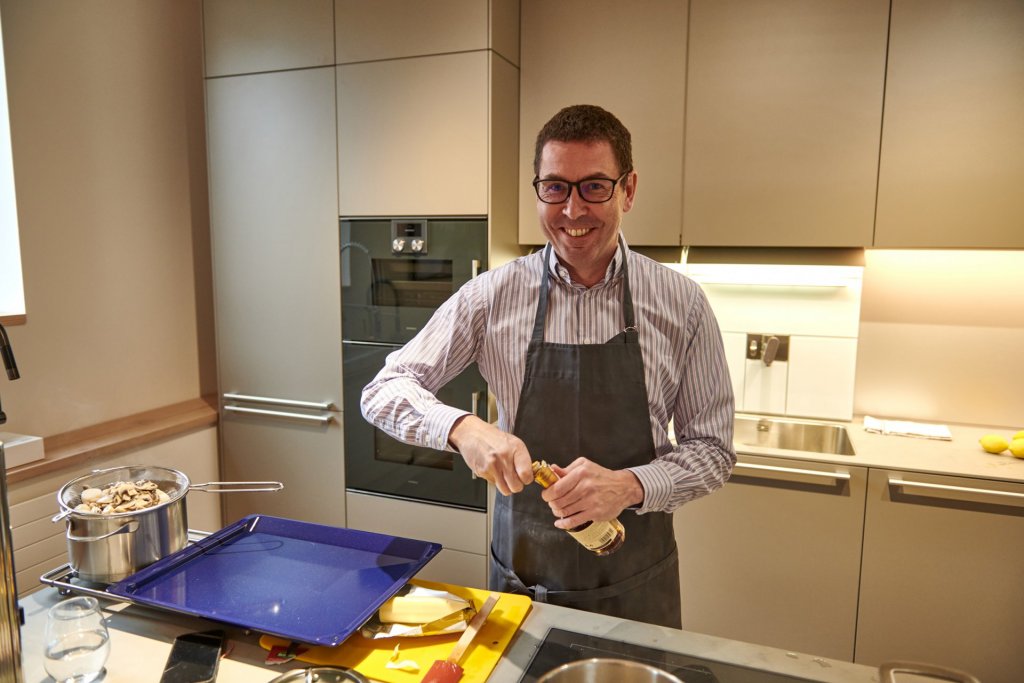
Do you miss the cuisine of your native country? What is the taste of England like?
Tough question. I was born in the 1960s, and in the 1970s everything was influenced by American culture. We fed on half-cooked or canned food and frozen dinners. We didn't have quality food at home. My mom wasn't the handiest of cooks...it just wasn't her passion. The tastes of my childhood include good British bacon, sausages and canned tomato soup. Such things that can always attract. It's not art, it's simple food. But they are the tastes I grew up on and they've stuck with me. Good-quality British cuisine is fantastic, but unfortunately we didn't have it at home too often. In the Czech Republic, you were better off at that time. You always enjoyed the tradition of having your own gardens and home-grown vegetables, whereas we took the path of less healthy foods. Fortunately, those times are long gone.
Are baking and cooking the same ritual for you?
Not by a long shot. Because when you bake, you have to be precise, but when you cook, you do it by feel. Being off by 10 grams of flour or butter when baking will make a difference. I know this very well and I stick to it, because I started working in a bakery after school when I was just thirteen years old. On the other hand, I cook more according to taste than based on some recipe. The key is to keep tasting it while cooking. Only then will you know what the food is really like, and you can take it to perfection.
You mentioned that you worked in a bakery, what other experience did you gain?
I think that like most people, I’ve held a lot of part-time jobs in my time. I worked in several restaurants and bars, washed dishes and cleaned. But it was interesting in that bakery. I was young and worked for a pastry chef who made spectacular cakes for birthdays and weddings. The work there was challenging, but such schooling paid off.
How did you get into development? What was your path to the building industry?
Besides part-time jobs in the hospitality industry, I also tried my hand at manual labor at a construction site, and because I gradually realized that I was interested in and enjoyed this field, I worked my way through the position of deputy site manager to project management. I continued to work at construction sites in England for 10 years, until 1996. My company then opened a branch in the Czech Republic with employees who were native English speakers, so that's actually how I ended up here.
Do you ever feel drawn back to England? What is the situation on the local development market?
Much time has passed since I started working in the Czech Republic and Slovakia. For young managers in England, chances for advancement are rather slim, and everything is controlled by processes typical of large companies. When I came to the Czech Republic in 1996, I was an ambitious young man, many opportunities opened up for me, and I was happy to capitalize on them. Czechs and Slovaks alike were very helpful and kind to me. Now I have Czech citizenship, I am Czech, and I plan to stay here. I don't desire to go back. I'm already home here.
I must mention that you speak very good Czech. Was our language a big obstacle for you at first?
It is true that the language was a huge limitation, but I learned Czech rather quickly. During the first two years, I worked my way up to some basic level of Czech and then gradually improved. But the early days were really scary (laughs). It helped to have friends here. In Prague, you can speak English in shops and restaurants, but I worked a lot in Moravia and Slovakia, and I would not have been able to do without knowing the local language.
What project is CRESTYL currently working on that represents the biggest challenge for you?
I think the biggest challenge for me at the moment is Savarin Palace. I am honored to work with Thomas Heatherwick's studio and the Mucha Foundation on a project in the heart of Prague, where Mucha’s famous Slav Epic will be exhibited. This is, of course, a great pleasure and a great honor... However, in my opinion, everything CRESTYL does is unique. That’s because we don't have a standard project. Our projects really transform places and cities, you can see it in the OC Dornych shopping center in Brno or right at Savarin, which I mentioned first. These are wonderful, huge projects that bring me joy.
Even in the post-Covid era, CRESTYL does not compromise on its priorities, which are quality and design. What do these two terms mean to you?
Design is a broad term. In our company, this means that everything is perfectly thought out, interconnected. That we comprehend the necessary context and respect the location in order to get the best out of our projects. This also applies to interior design. Customers knows that we have devoted maximum attention down to the last detail, they feel it. And in terms of quality, this is represented back in our country by the concept of reliability. In short, when clients buy a property from CRESTYL, they can rely on it being a sound investment.
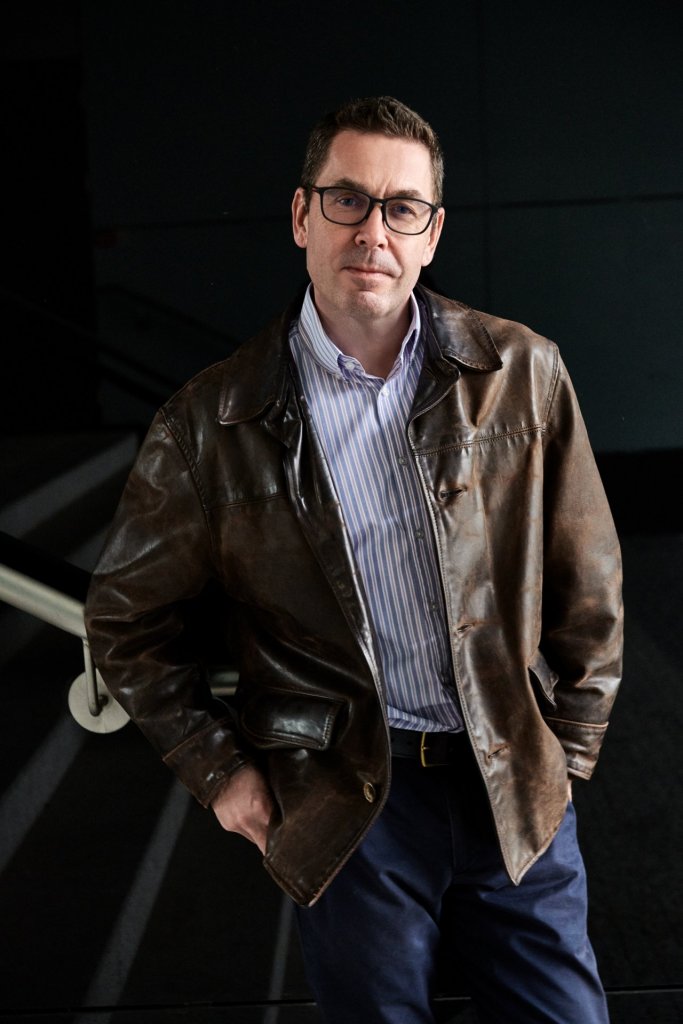
How are quality and design reflected in the construction and renting of offices? What demands are placed on the offices of today, on a truly modern and functional workspace?
At CRESTYL, we approach these spaces in our own way. We devote extra attention and resources to spaces outside the office. Of course, we care about functionality, but not functionality alone. Other elements are also vital – terraces connecting interiors with the external environment, areas with water, fountains... All this is crucial and typical for our projects. The technical equipment and facilities in our solution do not differ much from others. But our priority has always been that everyone working in our building should love coming to work and enjoy the environs. Employers as our tenants create conditions for their employees, and we create the environment for them all. In doing so, we help tenants reach their business objectives.
The environment and conditions for work and life outside the walls of offices are also related to the currently much-discussed term ESG. How does it work in CRESTYL and how do you perceive it?
According to ESG (Environment, Social, Governance) criteria, we can determine how a company approaches environmental issues, the benefits of its projects for communities and, last but not least, care for employees and people in general who have anything to do with the company. For CRESTYL, all these areas are naturally important, and we even consider them a necessity. For example, our buildings are always public and open, built in already built-up areas, but I probably perceive the most in my daily work the emphasis on the corporate culture and its approach towards people in general. It matters to us for our employees to be satisfied, that they (and our tenants’ employees) work well in the environment we create for them and, for example, that they have a place to relax and not just stare at screens all day, where they can chill out close to nature... We also, for example, see to maintaining a balanced top management structure so that women are adequately represented, we also have older employees, and so on.
Is ESG a common practice in the Czech Republic?
It's certainly not standard yet, but it's starting to be discussed more. So we're not the only ones considering ESG a priority, but it's certainly more evident here than with most of our competitors. Personally, I consider ESG to be one of the pillars of my work at CRESTYL.
You work in a male-dominated environment. How much has female energy permeated the development business over time?
I don't think that the construction industry is predominantly male. For example, among my employees, 51% are female, and there are several women on our board of directors. Personally, I see CRESTYL as a culture of "powerful women" where they can achieve success as well as men. Feminine power in our company is in the majority and we welcome that. This creates balance because women and men have differing points of view. I do not believe at all that development is a purely male area.
Let's go back to the kitchen for a moment... What about gastronomy? What do you think men and women bring to this arena?
That's a very dangerous question (laughs), but I don't have that one quite pinned down yet. I know a lot of fantastic chefs of both sexes. I think women and men are equally represented in this sector, and I certainly welcome this harmony!
Thanks for the interview.
Thank you for providing space to bulthaup Prague studio.
Soupe à l’Oignon Gratinée
Julia Child’s French onion soup
- 700 grams or about 5 cups chopped yellow onion
- 3 tablespoons butter
- 1 tablespoon oil
- 1 teaspoon salt
- 1/4 teaspoon sugar
- 3 tablespoons flour
- 2 liters beef stock
- 1/2 cup dry white wine or vermouth
- Black pepper to taste
- 1 teaspoon salt
- 3 tablespoons cognac
To serve
- 12 to 16 slices of white bread (croutons)
- Olive oil or beef fat
- 1 garlic clove
- Grated Swiss cheese or Parmesan
Beef stock
- 12 cups beef bones with meat
- 2 teaspoons salt
- 2 carrots
- 2 onions
- 2 stalks celery
- Herbs in a bundle sack: 2 sprigs thyme, 1 bay leaf, 6 sprigs parsley, 2 unpeeled cloves garlic, 2 whole cloves
- Optional: 2 small leeks
Start with the broth. Cover the meat and bones with cold water about 5 cm above the contents of the pot and slowly bring it to a boil. As soon as the water begins to bubble, skim the foam off the surface until it stops forming. The broth should never boil vigorously, otherwise the foam will disperse and become cloudy. Then add the cleaned vegetables and the rest of the ingredients to the saucepan, you can add a little water to make sure everything’s submerged. Skim off more foam as needed, but keep the pot partially covered with a lid. Always leave a small gap for steam to escape, otherwise there is a risk that the broth will sour. Cook for about 4 to 5 hours on a very low flame, so that only occasionally a solitary bubble appears. Check the broth from time to time, skim off the foam or excess fat and add water so that the ingredients remain submerged. As soon as you decide that there could be no more extractable flavor from the meat and vegetables, it's done. Strain the pure broth and proceed to preparing the onion soup, or let it cool completely without a lid.
Slowly sauté the finely chopped onion in butter and oil for about 15 minutes. Then raise the temperature slightly and add the salt and sugar. With frequent stirring, cook for another 30 to 40 minutes until the onions are soft and golden brown. Then dust it all with the flour, stir for 3 minutes and remove from the flame. Heat the prepared broth until it boils and pour it in with the onions. Add the wine, season as needed and cook for another 30 to 40 minutes, stirring occasionally. Finally, taste once more.
If you prepare the soup in advance, which is perfectly fine, let it cool fully and then reheat. Stir the cognac in just before serving. Divide it into baking soup bowls (crocks) and place a slice of pre-toasted bread (croutons) on each serving, which should be beautifully dry and golden brown by coating with olive oil or rendered beef fat. Sprinkle the croutons with the grated cheese, drizzle with olive oil or butter and bake all portions in the oven for about 20 minutes. As the last step, you can use the broiler to brown up the cheese and bread. Serve hot.
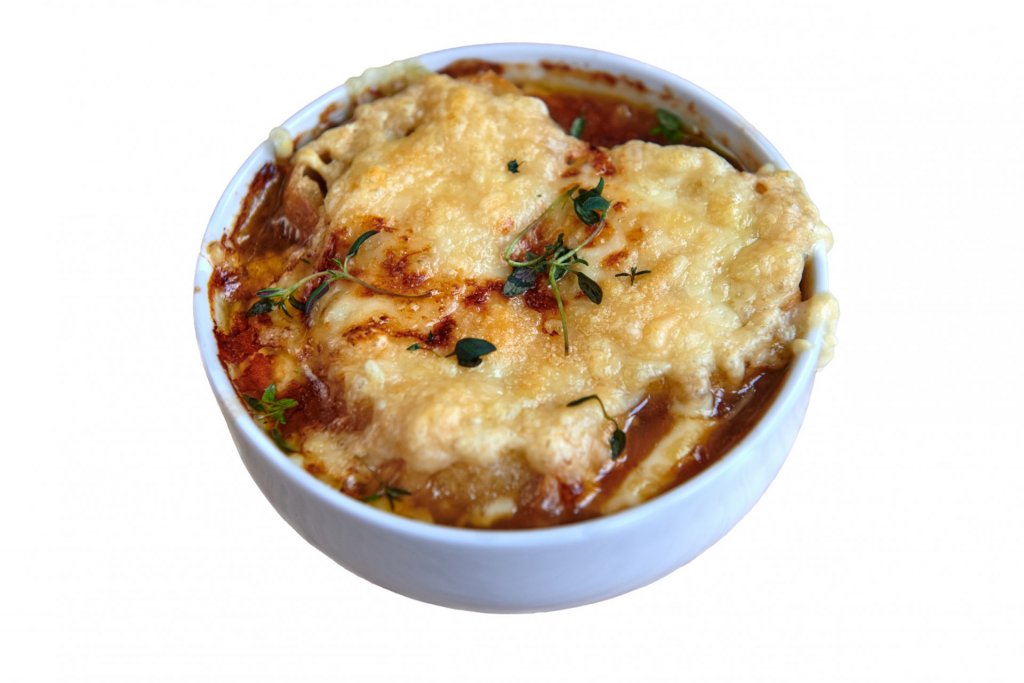
Coquilles St. Jacques à la Provençale
Julia Child’s scallops gratineed in wine with garlic and herbs
- 1/3 cup finely chopped yellow onion
- 3 tablespoons butter
- 1 and 1/2 tablespoons shallots or green onion finely chopped
- 1 clove finely chopped garlic
- 675 grams scallops
- Salt and pepper
- 1 cup flour
- 1 tablespoon olive oil
- 2/3 cup dry white wine (or a little less vermouth and splash of water)
- 1/2 bay leaf
- 1/8 teaspoon thyme
- 1/2 cup heavy (30%) cream
- 1/4 cup grated Swiss cheese
- 2 tablespoons butter, cubed
Sauté the onions in a tablespoon of butter for about 5 minutes until they are translucent, but not yet brown. Add the shallots or green onion and garlic and cook for about 1 more minute on low heat. Set aside.
Dry the washed scallops and cut them into slices of about half a centimeter. Lightly salt them, pepper them and dust them with a thin layer of flour. Then quickly sauté them in 2 tablespoons of butter with olive oil for about 2 minutes. Add to them the wine, herbs and sautéed onions and garlic. Cook everything on low under a lid for about 5 minutes. Check if the liquid has thickened slightly, possibly cook a little while longer.
Season once more to taste and remove the bay leaf. Move the scallops and sauce into a baking dish (you can also use the original shells to bake everyone's own portion in such stylish "cookware"), pour in the cream, sprinkle with cheese and top with butter cubes. Now you can either broil everything for about 3-4 minutes, or you can leave it ready and gratin until just before serving. Serve with a well-chilled rosé or dry white wine, ideally from Provence.
